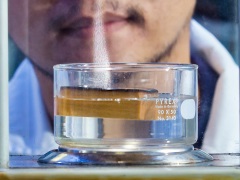Features
Water from wood
Date: 2017-11-15 16:17:28.0
Author: Jon Evans

Testing wood-based SSG, with the burnt
layer clearly visible.
Photo: University of Maryland.
Wood has long been used as a construction material, even though the kinds of things it is being used to construct are expanding all the time, from housing and furniture to loudspeakers and clothing (see Wood: looking good and sounding good). Researchers in Switzerland are even using wood to produce a lightweight form of concrete. But in a new paper in Joule, a team of US researchers report that wood can also make a highly effective material for a completely different application: turning dirty water or saltwater into clean drinking water.
The basic process is very simple, having been used for thousands of years, and simply involves using sunlight to evaporate away the water, leaving behind the salts and unwanted contaminants. The resultant water vapor can then be condensed to produce clean drinking water.
Simple it may be, but in it’s basic form this process is not very efficient, so scientists have recently come up with a more advanced version. This involves using some kind of porous material with a light-absorbing surface to suck up the water. The light-absorbing surface heats up on exposure to sunlight, promoting evaporation of the sucked up water from this surface, which causes more water to be sucked up via capillary action. In this way, water is constantly transported through the material to the surface, where it evaporates away, leaving behind the salt and contaminants.
For this process, known as solar steam generation (SSG), to work as effectively as possible, the material obviously needs to be porous, so that it can suck up water, and to posses a light-absorbing surface. But it also needs to have a low thermal conductivity, so that the bulk of the material stays cool while the surface gets hot, because efficient transport of water through the material relies on water only evaporating from the surface.
Scientists have investigated various materials with these kinds of properties for use in SSG, including graphite and copper nanotubes. Wood is another potential option, as it is porous with a low thermal conductivity, while also much cheaper than graphite or copper nanotubes. Furthermore, one of the main functions of wood is transporting water up the tree and so it has vertical channels running through it to aid this transport. What it doesn’t have, though, is a particularly light-absorbing surface, but it can be given one by coating it with light-absorbing materials such as graphene or carbon nanotubes.
An even simpler way to give wood a light-absorbing surface is to burn it, producing a dark, carbonized layer that will naturally heat up on exposure to sunlight. This is what Liangbing Hu and his colleagues at the University of Maryland did, by placing one side of a thin piece of wood on a hot plate at 500°C for just one minute. They tried this with three different types of wood – pine, poplar and cocobolo – that differed in their density and porosity. Although porosity is essential for SSG, density is also useful, because denser materials tend to heat up more.
When Hu and his colleagues tested these three pieces of burnt wood by illuminating them in a container of water, they found that poplar wood performed best, able to evaporate water at an impressive rate of 12kg per m2 per hour. Investigating further, they found that burnt poplar wood could absorb 92% of the incident light, raising the temperature of the burnt surface from 20°C to 92°C. This was less than cocobolo (96% and 99°C) but more than pine (84% and 85°C). Poplar still performed better than cocobolo overall because of its greater porosity, which not only enhanced water transport but also gave it a lower thermal conductivity.
If this poplar-based SSG can be developed into a large-scale process, then it could provide an energy-efficient alternative to conventional desalination plants in sun-baked, water-scarce countries such as Saudi Arabia.
The views represented here are solely those of the author and do not necessarily represent those of John Wiley and Sons, Ltd. or of the SCI.
Displaying 7 keywords used to tag this article:
- Montblanc Meisterstuck Doue Black &
- Moncler жилет женщины :
- Fake Cool Rolex DateJust Automatic
- Hublot часы: AAA часов ш
- Реплика Rado часы
- Replica Rolex GMT-Master II Watch -
- New Balance Серый Золото
